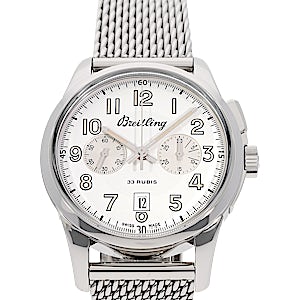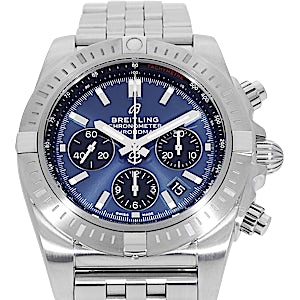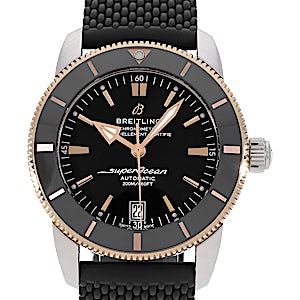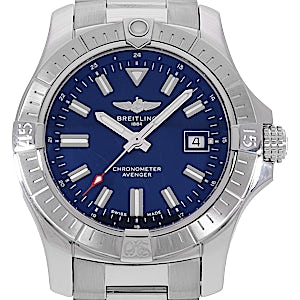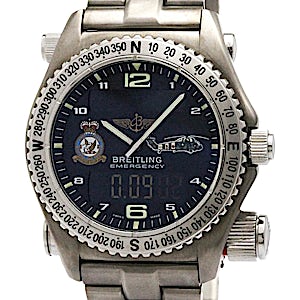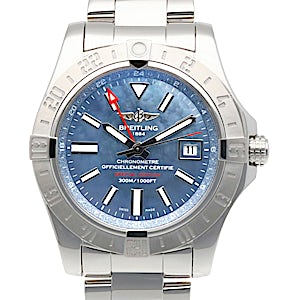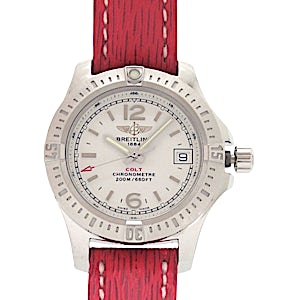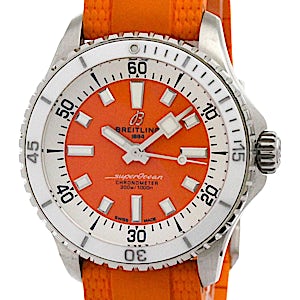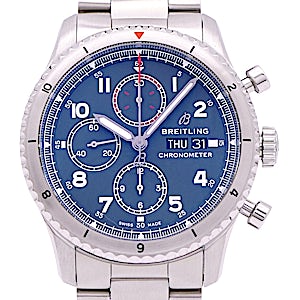The close to 150 years of model history have left their mark: the Breitling collection is versatile and highly functional. In addition to universal, elegant sports watches like the Chronomat, pilot's watches, like the Navitimer, and diving watches, like the SuperOcean or SuperOcean Heritage, can be found. Elegant timepieces such as the Premier or the Transocean are also available. You can buy all these models in a wide selection at attractive prices in our online shop.
Breitling Navitimer
The Navitimer is one of the greatest icons in the watch world and one of the most famous Breitling models. The watch with the distinctive slide rule has accompanied professional pilots and aviation enthusiasts since the 1950s. To this day, the appearance of the classic Navitimer has hardly been changed. In addition to the conventional model, numerous exciting variants of the slide rule chronograph are available. These include the still relatively young Navitimer 8 series but also watch such as the Navitimer Montbrillant or the Navitimer Cosmonaute.
The prices for the Navitimers are extremely stable. Especially for older classics like the Breitling A23322, prices are gradually starting to rise. Vintage models in the collection are still an insider's tip: especially compared to vintage watches like the Rolex Submariner or the Omega Speedmaster, vintage Navitimer prices are still undervalued. However, the prices for vintage Navitimers will likely rise in the next few years. The sooner you buy, the more money you can save!
Breitling Chronomat
The Chronomat is the oldest model of the Grenchen-based company. Originally, the Chronomat was a slide rule chronograph and thus the predecessor of the legendary Navitimer. In 1984, Breitling finally presented a classic of the 1980s with the Ref. 81950: this Chronomat model was characterised by classic 80s elements. These include, above all, the rouleaux bracelet and various bi-colour elements. While the Chronomat of the 2000s took up the 1980s style in a modernised form, Breitling launched a revival of the 80s Chronomat in 2021. This revival also saw the return of the distinctive yet comfortable Rouleaux bracelet.
Both the vintage models from the 1940s and 1980s and the current Chronomat are a bargain. In our online shop, you can buy both the old and the new references at reasonable prices.
Breitling Avenger
With the Avenger, Breitling offers a performance watch for many purposes. It is a toolwatch known for its high level of reliability and functionality in the air, on land or in the water. Thanks to the variety of models, the Avenger is available in different materials and colours as well as with various complications. In addition to stainless steel and DLC-coated titanium, there are models with black, white, blue or green dials. One of the highlights is the Avenger 45 Seawolf with a yellow dial. Avenger models such as the Avenger GMT with a second-time zone or the Avenger Chronograph are also popular.
The prices for the Avenger differ depending on the reference: While some older models are already available from 2,000 euros, high-tech models with innovative materials or sophisticated functions can command prices of 6,000 euros and more.
Breitling Transocean
The Transocean was presented in 1958. Breitling intended the travel chronograph to follow the success story of the Navitimer. The Transocean is one of the few heritage models launched before the Kern era: The Re-Edition was launched in 2010 and was available in 38 and 43 millimetres. This makes the Transocean an ideal watch for both men and women. The model is characterised by a perfect balance of sportiness and elegance and takes up where the historical model left off - without resorting to typical heritage elements such as Fauxtina.
Since the Transocean was discontinued a few years ago, it is now only available from independent dealers - for example, in our online shop. When you buy a Transocean from us, you benefit from low prices and excellent service.
Breitling Colt
The Breitling Colt is one of the best sports watches and a stylish, reliable companion for every day. The watch is suitable both as an entry dose into the world of fine timepieces and as a daily rocker for the office and leisure time. The reference A17035, in particular, is a popular entry-level watch due to its almost unbeatable price-performance ratio. The Colt cuts a fine figure not only on a steel bracelet but also on leather straps or the Breitling rubber straps. The model, which had been an integral part of the Breitling range since the 1980s, was revised in 2018. The discontinuation of the Colt series was later announced at the beginning of 2020.
Although there are still remaining stocks of the popular model, it is only a matter of time before the Colt is no longer available as a new watch. For this reason, prices are expected to rise soon. At CHRONEXT, you will find both the latest Colt models and the earlier references at fair prices - Both variants have their very own charm.
Breitling SuperOcean Heritage
One of the most famous heritage models from Breitling is the SuperOcean Heritage: this homage to the SuperOcean from 1957 was presented for the 50th anniversary of the original model and is characterised by the unique hands and the striking milanaise strap (mesh bracelet). The watch, which is available in 38 and 46 millimetres, was replaced by the Breitling SuperOcean Heritage II in 2017 to mark its 60th anniversary. The design of its successor was carefully revised, with the 38-mm version giving way to a four-millimetre larger version. In the meantime, the SuperOcean Heritage collection has been complemented by fashionable pastel versions and the striking Capsule Collection with concave bezels. This shows that the Breitling SuperOcean Heritage has enormous potential.
Whether it's the Avenger, Colt, Navitimer or SuperOcean, you will find numerous Breitling models with attractive price discounts in our online shop. Vintage lovers will also get their money's worth: in addition to new models, you will find used watches as well as vintage references. Every watch comes with our 24-month CHRONEXT guarantee, which documents our adherence to our strict authenticity and quality standards. For this reason, you can also buy long discontinued or historic watches. With CHRONEXT, you enjoy maximum security.

